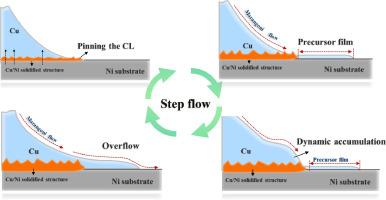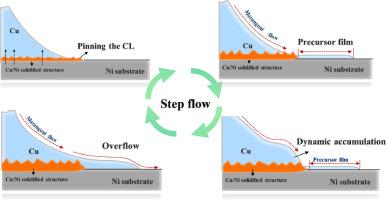溶解润湿铜/镍体系中的阶跃流动机制
IF 9.3
1区 材料科学
Q1 MATERIALS SCIENCE, MULTIDISCIPLINARY
引用次数: 0
摘要
铜-镍体系是一个典型的溶解体系,因为它在很宽的温度和成分范围内相互溶解。我们结合高温润湿实验、原位观察扩散和凝固、淬火液滴的微观结构分析以及计算流体动力学(CFD)模拟,研究了镍溶解对液态铜润湿行为的影响。在 1100 ℃ 时,铜液滴与镍基底接触的初期,由于毛细管效应,液滴会发生振荡,并受到惯性效应的抑制,而 1150 ℃ 时镍的大量溶解在很大程度上减少了初期的振荡。后来,我们观察到了一种奇特的扩散行为,并建议通过以下四步机制来描述这种行为:在界面上新形成的固溶体层作为物理屏障将接触线固定;由于镍浓度引起的马兰戈尼流,液体被驱向凝固边缘;由于强烈的铜镍相互作用和马兰戈尼流,在凝固边缘前形成了前驱膜;最后,由于凝固边缘的液体积聚导致溢流,从而造成去薄化。现场观察和淬火证实了固溶层的形成。镍浓度诱导的马兰戈尼流具有实验特征,并通过 CFD 模拟进行了进一步研究。所提出的阶梯流动机制可能与其他溶解润湿体系(如 Bi/Sn、Ag/Cu 和 Cu/Fe 体系)相关,这些体系对于高温加工技术至关重要。本文章由计算机程序翻译,如有差异,请以英文原文为准。


Step flow mechanism in dissolutive wetting Cu/Ni systems
The Cu-Ni system is a typical dissolutive system due to its mutual dissolution across a wide range of temperatures and compositions. We characterized the effects of Ni dissolution on the wetting behavior of liquid Cu by combining high-temperature wetting experiments, in-situ observation of spreading and solidification, microstructure analysis of the quenched droplets, and computational fluid dynamic (CFD) simulations. In the very early moment, at 1100 °C, when the Cu droplet is brought in contact with the Ni substrate, it oscillates due to capillarity and is dampened by inertial effects, while the significant Ni dissolution at 1150 °C largely reduced the initial oscillations. Later, a peculiar spreading behavior is observed and we propose to describe it through a 4-step mechanism: pinning of the contact line by a newly formed solid solution layer at the interface acting as a physical barrier, driving of liquid towards the solidified edge due to a Ni-concentration induced Marangoni flow, forming of a precursor film ahead of the solidified edge caused by the strong Cu-Ni interactions and Marangoni flow, and finally depinning due to overflow as a result of liquid accumulation at the solidified edge. The formation of a solid solution layer is confirmed by in-situ observation and quenching. The Ni-concentration induced Marangoni flow is characterized experimentally and further investigated by CFD simulations. The proposed step flow mechanism can be potentially relevant to other dissolutive wetting systems (e.g. Bi/Sn, Ag/Cu and Cu/Fe systems), which are crucial for high-temperature processing techniques.
求助全文
通过发布文献求助,成功后即可免费获取论文全文。
去求助
来源期刊

Acta Materialia
工程技术-材料科学:综合
CiteScore
16.10
自引率
8.50%
发文量
801
审稿时长
53 days
期刊介绍:
Acta Materialia serves as a platform for publishing full-length, original papers and commissioned overviews that contribute to a profound understanding of the correlation between the processing, structure, and properties of inorganic materials. The journal seeks papers with high impact potential or those that significantly propel the field forward. The scope includes the atomic and molecular arrangements, chemical and electronic structures, and microstructure of materials, focusing on their mechanical or functional behavior across all length scales, including nanostructures.
 求助内容:
求助内容: 应助结果提醒方式:
应助结果提醒方式:


